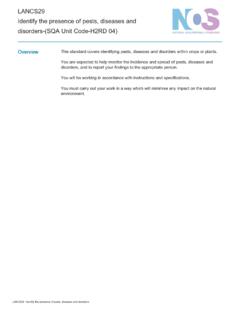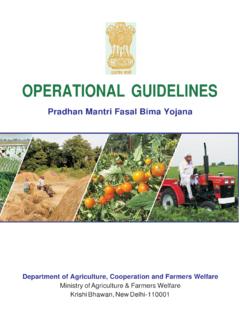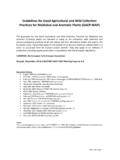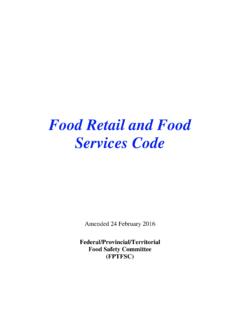Transcription of HACCP Manual 2011
1 HACCP Hazard Analysis & Critical Control Point Planning to Prevent the Spread of Invasive Species Edited by David Britton, Paul Heimowitz, Susan Pasko, Matthew Patterson, and Jonathan Thompson June 2011 i USFWS-NCTC Table of Contents Acknowledgements .. ii Chapter 1: Invasive Species Impacts .. 1 Invasive Species Impacts .. 1 Pathways .. 2 Invasive Species Legislation .. 4 Chapter 2: What is HACCP ? .. 6 What is HACCP ? .. 6 The Origins of HACCP .. 7 Planning is Essential .. 7 Five Steps to HACCP Planning .. 9 Starting Out in the Right Direction .. 9 Chapter 3: Case Studies: When HACCP Could Have Helped .. 11 Inks Dam National Fish Hatchery .. 11 Ridgefield National Wildlife Refuge .. 12 Chapter 4: HACCP 14 Step 1 Activity Description.
2 14 A Hypothetical Example .. 16 Step 2 Activity Flow Chart .. 19 Step 3 Potential Non-Targets .. 24 Step 4 Non-Target Analysis Worksheet .. 28 Analyzing the Risk of Non-targets .. 30 Developing Effective Control Measures .. 33 Determining Critical Control Points .. 38 Critical Control Point Decision Tree .. 41 Step 5 Non-Target Risk Action Plan (NTRAP) .. 43 Chapter 5: Implementing HACCP .. 52 Chapter 6: Glossary .. 54 Chapter 7: References .. 58 Appendix A: Blank HACCP Forms .. 70 Appendix B: Example HACCP Forms (Completed) .. 75 Appendix C: Risk Assessment Diagrams .. 83 Risk Assessment Diagram for Aquatic Management Activities .. 83 Risk Assessment Diagram for Terrestrial Management Activities .. 84 Risk Assessment Diagram for Movement of Natural Resources .. 85 Appendix D: Critical Control Point Decision Tree.
3 86 June 2011 ii USFWS-NCTC Acknowledgements This course Manual was adapted from Aquatic Nuisance Species Hazard Analysis and Critical Control Point (ANS HACCP ) Training Curriculum, which was developed by the National Sea Grant College Program. In particular, the Fish and Wildlife Service thanks Jeffery L. Gunderson, Ronald E. Kinnunen, Patrice M. Charlebois, Douglas A. Jensen, Mike R. Klepinger, Eric C. Obert, and Fred L. Snyder for their efforts in adapting the use of HACCP for prevention of aquatic invasions. Many people have contributed to the current version of this Manual and associated training curriculum. Key partners include the State of Arizona Game and Fish Department, the State of Wyoming Game and Fish Department, and the National Oceanic and Atmospheric Administration. Valuable feedback from past course participants has also enhanced refinement of this Manual over time Thank you to the following sources of photos within this Manual : - Bob Pitman, USFWS - Stewart Jacks, USFWS - Steve Sharon, WGFD - Roger Sorenson, AZGFD/USFWS - June McIlwain, USFWS - Robert Lindsey, USFWS - Peter Pattavina, USFWS - Paul Nelson, USGS - Gordon H.
4 Rodda, USGS - John Hollingsworth, USFWS - Karen Hollingsworth, USFWS - Steve Hillebrand, USFWS - Jay Troxel, USFWS - Stuart Leon, USFWS - April Fletcher, USFWS - Dan Dinkler, USFWS Chapter 1: Invasive Species Impacts HACCP Planning to Prevent the Spread of Invasive Species _____ June 2011 1 USFWS-NCTC Chapter 1 Invasive Species Impacts Learning Objectives: At the end of Chapter 1, participants will be able to: identify invasive species impacts. define non-indigenous species vs. invasive species (and synonyms). define target, non-target, pathway and vector. identify local and global invasive species pathways. list key invasive species legislation Invasive Species Impacts Nationwide, the cost of controlling and managing invasive species has exceeded billions of dollars. In 2010, Sam Hamilton, former Director of the Fish & Wildlife Service, said that invasive species are probably the single greatest threat in our country to our native wildlife.
5 Invasive species impact our environment and the diversity of life on our planet in many ways. The ecosystems into which these organisms are introduced often lack the conditions that limit range expansion in their natural habitats ( , predators, pests, or diseases). This factor, accompanied by characteristics such as high reproductive rates, the ability to utilize a variety of resources, and wide tolerances to a range of environmental conditions, allow invasive species to spread quickly following introduction, often resulting in serious impacts to the environment. Consequences of invasion include the extinction of native species through predation, competition for food or space, hybridization, and introduction of harmful pathogens and parasites. Non- indigenous species also can profoundly alter ecosystems through changes to the food web, fire regimes, and hydrology.
6 Key Definitions: Invasive Species a non-indigenous organism whose introduction does or is likely to cause economic or environmental harm or harm to human health. Non-indigenous Species an individual, group, or population of a species that is introduced by human intervention into an area or ecosystem outside of its historic native geographic range. Synonymous with alien, non-native, exotic, and introduced. Chapter 1: Invasive Species Impacts HACCP Planning to Prevent the Spread of Invasive Species _____ June 2011 2 USFWS-NCTC In addition to the severe and permanent damage to the habitats they invade, invasive species also hinder economic development. Exotic organisms reduce production of fisheries, decrease water availability, block transport routes, foul industrial pipelines, degrade water quality, and decrease property values.
7 Through damage to human enterprises, invasive species inflict an enormous economic cost; the cost to manage non-native species in the is currently estimated at $137 billion per year. This number is likely an underestimate as it does not consider ecosystem health or the aesthetic value of nature, which can influence tourism and recreational revenue. Additionally, invasive species may serve as vectors of human disease. Throughout recorded history, epidemics such as malaria, yellow fever, typhus, and bubonic plague have used non-indigenous organisms as vectors. Waterborne disease agents, such as cholera bacteria (Vibrio cholerae), are often transported in the ballast water of ships. The effect of invasive species on public health extends beyond the immediate effects of disease and parasites, as chemicals used to control invasive species can pollute soil and water.
8 Other invasive species, including invasive mussels, may increase human and wildlife exposure to organic pollutants such as polychlorinated biphenyls (PCBs), as these toxins accumulate in their tissues and are passed up the food chain. Pathways Invasive species can arrive through many different pathways and vectors, but most species considered invasive in North America arrived as a direct result of human activity. For example, it is widely accepted that zebra mussels, Dreissena polymorpha, were introduced to the Great Lakes through ballast water discharge by ships arriving from foreign ports. Shippers did not intend to move zebra mussels when using ballast water to safely cross the ocean and manage cargo loading/unloading. Unfortunately, many species can survive transoceanic trips in ballast water, essentially hitchhiking to new ports.
9 Likewise, the horticultural industry has inadvertently provided pathways by which plant pests have been imported to the United States, causing problems in agricultural and natural areas. Some of our worst insect invaders, such as the Formosan termite (Coptotermes formosanus shiraki) arrived in packing and crating materials. These are just a couple of examples of how species are moved around the planet unintentionally. However, the problem is ubiquitous and all too common. Zebra mussels attached to a native freshwater mussel. Photo Credit: USFWS Chapter 1: Invasive Species Impacts HACCP Planning to Prevent the Spread of Invasive Species _____ June 2011 3 USFWS-NCTC Key Definitions: Pathway an activity or process through which a species may be transferred to a new location where it could become invasive ( , shipping, air travel).
10 Vector the specific means by which an invasive species moves within a particular pathway ( , a ship, agricultural products, boots). On a local scale, invasive species can be spread unintentionally to new habitats through a wide variety of human activities, including work in natural resource management. For example, the tiny size of the New Zealand mudsnail (Potamopyrgus antipodarum) and its ability to clone itself help this species invade new water bodies by hitchhiking to new habitats on targets such as waders, boats, and other aquatic gear. Similarly, terrestrial species can be moved via field or farm equipment, clothing, and/or native species that are moved to new areas for conservation purposes. Species monitoring, collections, natural resource surveys, and stocking of fish are all potential pathways for moving invasive species during natural resource management activities.






